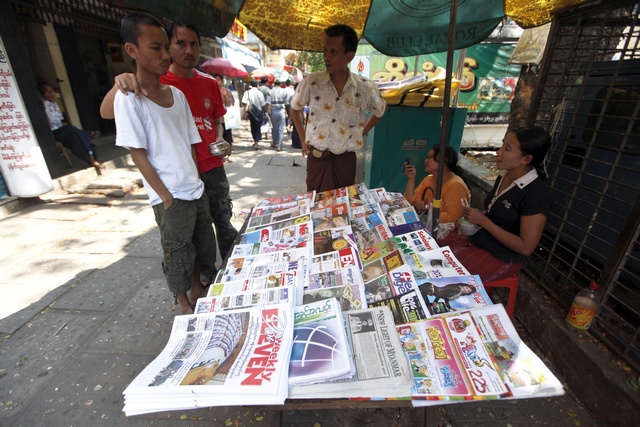A curious conference took place on Monday between several Associated Press (AP) reporters and the state-run News and Periodicals Enterprise (NPE) in Rangoon.
Burma’s Ministry of Information (MOI) announced on 20 January that three AP reporters – Robin McDowell, Gemnu Amarsinghe and Ma Esther – were told that the AP staff bureau in Rangoon will be considered “responsible” for any unrest resulting from their coverage of events in Arakan [Rakhine] State last week.
The AP, however, provided a different account of the meeting, which took place two days after state media accused the agency of false reporting.
NPE’s daily newspaper New Light of Myanmar on Saturday ran an article entitled, “AP, Irrawaddy falsely reports violence occurred in Rakhine State,” citing a policeman in Maungdaw, who denied that any violence occurred. The article concluded that, “It is found that the reports of killings caused by racial and religious conflicts by AP and The Irrawaddy news agencies seemed to instigate unrests.”
In AP’s defense, Paul Colford, Director of Media Relations for the agency, issued the following statement:
“I wish to clarify and underscore AP’s position with regard to our coverage of the recent violence in Northern Rakhine. We believe AP’s reporting on the situation has been careful and responsible. We stand by our coverage.”
A statement on the Ministry’s website said the three aforementioned reporters were summoned to the offices of the NPE, MOI’s publishing company, where they were accused of reporting “erroneous” information and told that resultant disturbances would be seen as their responsibility.
“The information published in the news article: ‘Myanmar Mob Kills more than a dozen Muslims’, published on AP’s website on 17 January differed from the real situation,” read the statement.
“[Managing director Kyaw Soe] said the AP bureau will be responsible if incidents take place that can damage tranquility and the Rule of Law because of the agency’s reporting.”
[related]
DVB contacted the Ministry on Tuesday for further details about the meeting. Hlaing Myint, director of News and Periodicals Enterprise, said, “I understand that the AP bureau may possibly have to answer to the Interim Press Council if impact from their reporting escalates – this is just a possibility from my understanding.”
Hlaing Myint did not offer, when prompted, any details about what consequences might ensue or exactly how causality could be determined between the AP report and any subsequent unrest.
The AP says that no warning was issued, but that reporters did have a cordial discussion with the managing director of the News and Periodicals Office on many subjects, including the recent violence in northern Arakan State.
The contentious article, first published by AP under the headline “Group: Myanmar mob kills more than a dozen Muslims” by Robin McDowell on 17 January 2014, cited “a villager and a rights group,” who claimed that, based on witness testimony, violence broke out in northern Arakan State early last Tuesday between the area’s majority Muslim Rohingyas and Buddhist Arakanese.
The primary source for the report was Chris Lewa, director of the Arakan Project, who has maintained confidential sources among Rohingya populations in northern Arakan State for about ten years. Lewa reportedly said that while her sources offered some conflicting testimony, the incident was thought to have left several people dead with estimates ranging from 10 to 60 as of Friday.
Monday’s statement by the MOI called the agency’s professional ethics into question because the journalists “made contact to neither the Ministry of Home Affairs nor the Ministry of Information to verify the information.” The statement said that the NPE urged AP and other agencies “to refrain from reporting groundless and erroneous news that can mislead readers, and instead to report news in accordance with journalism guidelines.”
The incident that caused the media stand-off occurred in one of Burma’s several restricted areas, for which journalists and other observers are required seldom-attainable entry permits.
This issue of access was addressed in Colford’s response to the initial flare-up.
“To ensure an even clearer picture from northern Rakhine, we urge the government to allow access to the region,” read his statement.
The AP opened a full news bureau in Burma in March 2013, the first international news agency to operate openly in Burma since the shift to a quasi-civilian government in 2011. Reforms over the past two years have relaxed many of the former restrictions of the once-closed country, which until August 2012 subjected all print media to a pre-publication censorship board.
Despite new freedoms in publishing and digital media, restrictions on media freedom persist. In June 2013, the Burmese government banned an issue of Time magazine featuring a cover story about Buddhist monk Wirathu, leading advocate of a nationalist sect called 969. The outspoken monk is believed to have delivered nationalist sermons in several parts of the country that have later been host to communal violence, including Maungdaw.
Presidential spokesman Ye Htut said at the time that the publication was prohibited, “to prevent further racial and religious conflicts.”



